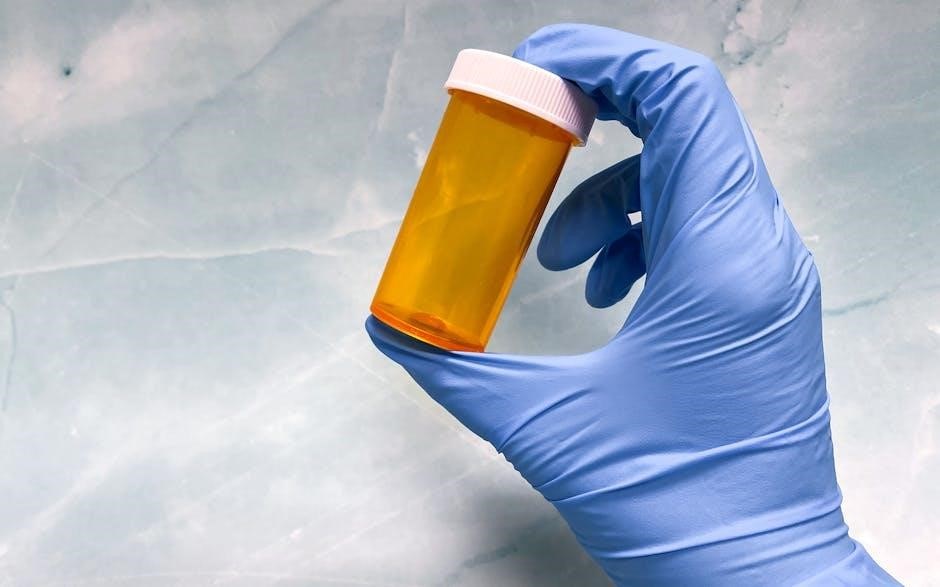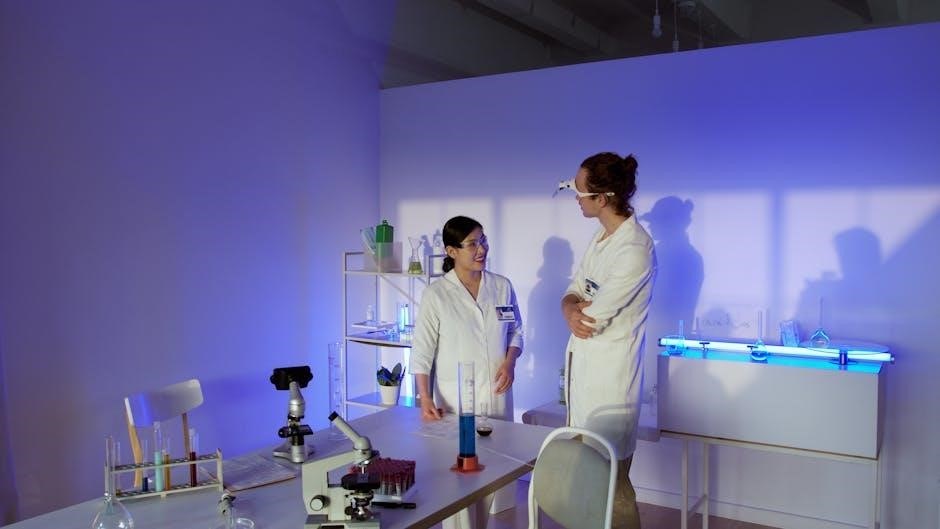Unit conversion is a fundamental concept in chemistry, enabling consistent and accurate measurements. It involves changing units without altering the quantity, crucial for problem-solving and data interpretation.
1.1 Importance of Unit Conversion in Chemistry
Unit conversion is essential in chemistry for ensuring consistency and accuracy in measurements. It allows chemists to compare data, perform calculations, and communicate results effectively. Accurate conversions prevent errors in experiments, formulas, and industrial processes. They also enable the use of standardized units, facilitating collaboration across different countries and industries. Mastery of unit conversion is critical for solving problems, interpreting data, and applying chemical principles in real-world scenarios, making it a foundational skill for all chemistry students and professionals.
1.2 Basic Concepts of Units and Measurements
In chemistry, units and measurements form the foundation of quantitative analysis. The International System of Units (SI) provides standardized units for length, mass, and volume, with the meter, gram, and liter being the base units. Prefixes like kilo, milli, and centi allow for scaling these units. Derived units, such as Celsius for temperature and watts for power, are also essential; Understanding these concepts ensures consistency and accuracy in chemical calculations and experiments, making them indispensable for chemists.

Fundamental Principles of Unit Conversion
Unit conversion relies on conversion factors and SI units to ensure consistency and accuracy in chemical calculations and experiments, forming the basis of precise measurements.
2.1 Understanding SI Units
SI units form the foundation of modern measurement in chemistry, providing a standardized system for consistency and clarity. The base units include the meter (length), kilogram (mass), and liter (volume). These units are universally recognized, ensuring accurate communication of scientific data. Understanding SI units is essential for converting measurements and performing calculations in chemistry. They also include derived units like the Kelvin (temperature) and ampere (electric current), which are critical for advanced chemical applications and experiments.
2.2 Conversion Factors and Their Applications
Conversion factors are ratios of equivalent measurements used to transform units within or between systems. They are derived from definitions or experimental data, ensuring precise calculations. In chemistry, conversion factors link SI and non-SI units, such as grams to kilograms or Celsius to Kelvin. These factors are essential for dimensional analysis, enabling accurate conversions in stoichiometry, density calculations, and molar mass determinations. Proper use of conversion factors avoids errors and ensures consistency in chemical problem-solving and laboratory measurements.

Common Unit Conversions in Chemistry
Common unit conversions in chemistry involve length, mass, and volume. Examples include meters to centimeters, grams to kilograms, and liters to milliliters. Metric prefixes simplify conversions.
3.1 Length, Mass, and Volume Conversions
Length, mass, and volume conversions are essential in chemistry. Length conversions involve meters to centimeters (1 m = 100 cm) or kilometers to meters (1 km = 1,000 m). Mass conversions include grams to kilograms (1 kg = 1,000 g) and milligrams to grams (1 g = 1,000 mg). Volume conversions often involve liters to milliliters (1 L = 1,000 mL) or gallons to liters. Metric prefixes like kilo-, milli-, and centi- simplify these conversions, ensuring accuracy in measurements and calculations.
3.2 Temperature Conversions (Celsius, Kelvin, Fahrenheit)
Temperature conversions are vital in chemistry for maintaining consistency. The Celsius scale is widely used, with water freezing at 0°C and boiling at 100°C. Kelvin, the SI unit, is used for absolute temperature, where 0 K is absolute zero. To convert Celsius to Kelvin, add 273.15 (e.g., 25°C = 298.15 K). Fahrenheit conversions involve the formula: °F = (°C × 9/5) + 32. Accurate temperature conversions are critical for chemical calculations, experiments, and data analysis.

Unit Conversions Involving Chemical Quantities
Unit conversions in chemistry involve grams, moles, and particles. Molar mass and Avogadro’s number are key for accurate calculations. Understanding these is essential for chemical problem-solving.
4.1 Converting Between Grams, Moles, and Particles
Converting between grams, moles, and particles is essential in chemistry. Grams to moles requires molar mass, while moles to particles uses Avogadro’s number (6.022 × 10²³ particles/mol). This process is fundamental for stoichiometry and chemical calculations. For example, grams of a substance can be converted to moles using its molar mass, and moles can then be converted to particles. Understanding these conversions is critical for solving problems involving chemical quantities and reactions.
4.2 Using Molar Mass for Conversions
Molar mass is a critical tool for converting between grams and moles. It represents the mass of one mole of a substance in grams. By dividing the mass of a substance by its molar mass, you can determine the number of moles. For example, to convert grams of sodium (Na) to moles, divide the given mass by sodium’s molar mass (23 g/mol). This conversion is vital for chemical calculations, stoichiometry, and understanding reaction ratios.

Dimensional Analysis in Unit Conversion
Dimensional analysis is a systematic method for unit conversion, ensuring units cancel out appropriately to yield the desired unit. It enhances accuracy and clarity in calculations.
5.1 Setting Up Conversion Factors
Conversion factors are ratios of equivalent quantities used to change units. To set them up, identify the known ratio between units, such as meters to centimeters (1 m = 100 cm). Use these factors to multiply or divide the given value, ensuring unwanted units cancel out. For example, to convert 5 meters to centimeters, multiply by the conversion factor (100 cm/m), resulting in 500 cm. This method ensures accuracy and simplifies complex unit conversions in chemistry problems.
5.2 Canceling Units to Reach the Desired Unit
Canceling units is a key step in dimensional analysis. By setting up conversion factors, units can be systematically eliminated to achieve the desired unit. For instance, converting grams to kilograms involves multiplying by the factor (1 kg / 1000 g), causing the gram unit to cancel out. This method ensures that only the target unit remains, providing a clear and precise result. Proper unit cancellation is essential for accurate calculations in chemistry and related fields.

Practice Problems and Worksheets
Practice problems and worksheets are essential for mastering unit conversion in chemistry. They provide exercises on conversion factors, SI units, and metric prefixes, reinforcing understanding through practical examples.
6.1 Sample Problems for Unit Conversion
Sample problems in unit conversion help students practice converting grams to moles, meters to centimeters, and kilograms to grams. For example, converting 500 grams of sodium chloride to moles requires using molar mass. Another problem might involve converting 100 meters to centimeters or 1 liter to milliliters. These exercises ensure mastery of conversion factors and dimensional analysis, essential for solving complex chemical calculations accurately and efficiently.
6.2 Solutions and Explanations
Solutions to sample problems demonstrate step-by-step conversions, ensuring clarity. For instance, converting 500 grams of sodium chloride to moles involves dividing by the molar mass (58.44 g/mol), yielding approximately 8.55 moles. Explanations emphasize using conversion factors and dimensional analysis to cancel unwanted units. Common errors, like incorrect unit cancellations, are highlighted, and tips for avoiding miscalculations are provided to enhance problem-solving skills and accuracy in chemical calculations.
Real-World Applications of Unit Conversion
Unit conversion is vital in medicine, engineering, and everyday tasks. For example, converting drug dosages ensures patient safety, while scaling recipes requires precise measurements. Chemistry underpins these applications.
7.1 Laboratory Measurements and Calculations
Laboratory work relies heavily on accurate unit conversions to ensure precise measurements and calculations. For instance, converting milliliters to liters or grams to kilograms is essential for preparing solutions and calculating concentrations. Incorrect conversions can lead to experimental errors, making it crucial for chemists to master this skill. Additionally, understanding conversion factors simplifies complex calculations, such as determining molar concentrations or reaction yields, which are fundamental in chemical analysis and experimentation.
7.2 Industrial and Everyday Uses of Unit Conversion
Unit conversion plays a vital role in industrial processes, such as chemical manufacturing, pharmaceutical production, and engineering. Accurate conversions ensure the correct proportions of ingredients, safety standards, and product quality. In everyday life, unit conversion is essential for tasks like cooking, construction, and fuel efficiency calculations. For example, converting liters to gallons or kilograms to pounds simplifies international trade and daily activities. Mastery of unit conversion fosters efficiency and precision in both professional and personal contexts.

Common Mistakes and Tips for Accuracy
Common errors include incorrect conversion factors and unit cancellations. To ensure accuracy, always use precise conversion tables and double-check calculations; Practice enhances proficiency and reduces mistakes.
8.1 Avoiding Errors in Unit Conversion
Avoiding errors in unit conversion requires attention to detail and proper use of conversion factors. Common mistakes include misplacing decimal points, using incorrect prefixes, and neglecting unit consistency. Always verify conversion factors from reliable sources and ensure units cancel appropriately. Double-checking calculations and using dimensional analysis can prevent errors. Practicing with sample problems enhances understanding and reduces mistakes. Consistency in applying SI units and prefixes is key to accurate conversions in chemistry;
8.2 Best Practices for Chemistry Students
Chemistry students should adopt best practices to master unit conversions. Start by understanding the relationship between units and their prefixes. Use conversion factors systematically, ensuring units cancel out appropriately. Regular practice with worksheets and online tools enhances proficiency. Always verify conversion factors from reliable sources and double-check calculations. Organizing notes with conversion tables and charts provides quick reference. Seeking help from instructors or study groups when confused fosters better understanding. Consistent practice and attention to detail are essential for accuracy in unit conversions.

Tools and Resources for Unit Conversion
Various tools facilitate unit conversion in chemistry, including conversion tables, charts, and online calculators. Academic resources like Prof. Faith A. Morrison’s work also provide essential support.
9.1 Conversion Tables and Charts
Conversion tables and charts are essential tools for unit conversion in chemistry. They provide standardized measurements, ensuring accuracy and consistency. Basic units like meters (length), liters (volume), and grams (mass) are foundational. Metric prefixes such as kilo (10³), milli (10⁻³), and centi (10⁻²) simplify conversions. These resources often include factors for length, mass, volume, and area, aiding in quick reference. They are particularly useful for students and professionals to verify calculations and maintain precision in chemical analyses and experiments.
9.2 Online Calculators and Software
Online calculators and software are invaluable tools for unit conversions in chemistry. They offer quick, accurate, and efficient solutions for complex conversions. Many platforms provide comprehensive unit libraries, allowing users to convert between various metric and imperial systems. Features like real-time calculations, conversion history, and downloadable results enhance productivity. Additionally, some software includes advanced functionalities for chemical quantities, such as molar mass calculations and density conversions. These resources are indispensable for students, researchers, and professionals, ensuring precision and saving time in chemical analyses and experiments.

Exam Preparation and Assessment
Mastering unit conversion is crucial for chemistry exams, as it frequently appears in problems. Practice worksheets and understanding common errors enhance problem-solving skills and accuracy.
10.1 Unit Conversion Questions in Chemistry Exams
Chemistry exams often include unit conversion questions, testing students’ ability to switch between units accurately. These questions may involve converting grams to moles, liters to cubic decimeters, or Celsius to Kelvin. They assess understanding of SI units, prefixes, and dimensional analysis. Common examples include calculating molar masses, converting volumes, and solving stoichiometry problems. Practicing these types of problems helps build proficiency and reduces errors during exams.
10.2 Strategies for Solving Conversion Problems
Mastering conversion problems requires a systematic approach; Start by identifying the given unit and the desired unit. Use conversion factors to bridge the units, ensuring they cancel appropriately. Dimensional analysis is key, as it helps maintain unit consistency. Break down complex conversions into simpler steps, and always verify the final unit matches the desired one. Regular practice and reviewing common mistakes enhance problem-solving efficiency and accuracy in chemistry exams.
Unit conversion is foundational in chemistry, ensuring consistency and accuracy in measurements. Mastering it enhances problem-solving skills and is essential for success in chemical studies and real-world applications.
11.1 Summary of Key Concepts
Unit conversion in chemistry is essential for consistency and accuracy in measurements. It involves understanding SI units, conversion factors, and dimensional analysis. Key concepts include converting length, mass, volume, and temperature, as well as handling chemical quantities like moles and molar mass. Avoiding errors and using best practices ensures reliability in calculations. Mastery of unit conversion is vital for problem-solving in chemistry, laboratory work, and real-world applications, making it a foundational skill for all chemistry students and professionals.
11.2 Final Thoughts on Mastering Unit Conversion
Mastering unit conversion is a critical skill in chemistry, ensuring accuracy and consistency in measurements. By understanding SI units, conversion factors, and dimensional analysis, chemists can tackle complex problems with confidence. Regular practice and attention to detail are key to avoiding errors. Proficiency in unit conversion not only enhances laboratory work but also supports real-world applications, making it an indispensable tool for chemistry students and professionals alike.

References and Further Reading
For further learning, refer to textbooks like “Chemistry: The Central Science” and online resources such as Khan Academy and Chemistry LibreTexts for comprehensive guides and practice problems.
12.1 Recommended Textbooks and Resources
For in-depth understanding, textbooks like “Chemistry: The Central Science” and “Chemical Principles” are highly recommended. Online platforms such as Khan Academy and Chemistry LibreTexts offer detailed guides and practice problems. Additionally, resources like Conversion Tables and SI Unit Guides provide essential reference materials for mastering unit conversions in chemistry.
12.2 Online Resources for Continuous Learning
Online resources like Khan Academy and Chemistry LibreTexts offer comprehensive guides and interactive exercises for mastering unit conversions. Websites such as UnitConverters.net and ChemCalc provide easy-to-use conversion tools. Additionally, platforms like Coursera and edX host courses that cover unit conversion in depth. Forums and communities, such as Reddit’s r/chemistry, also serve as valuable spaces for asking questions and sharing resources.
